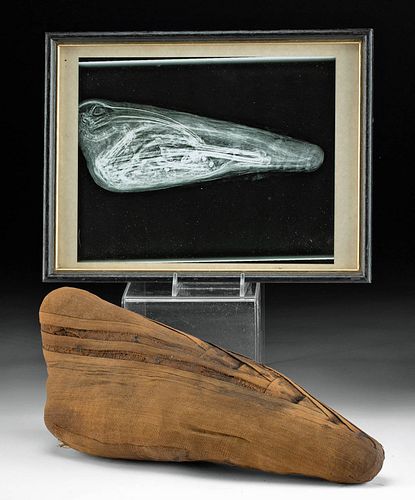Egyptian Mummified Ibis + x-Ray Photo - 1910 Provenance
About Seller
686 S Taylor Ave, Ste 106
Louisville, CO 80027
United States
Selling antiquities, ancient and ethnographic art online since 1993, Artemis Gallery specializes in Classical Antiquities (Egyptian, Greek, Roman, Near Eastern), Asian, Pre-Columbian, African / Tribal / Oceanographic art. Our extensive inventory includes pottery, stone, metal, wood, glass and textil...Read more
Two ways to bid:
- Leave a max absentee bid and the platform will bid on your behalf up to your maximum bid during the live auction.
- Bid live during the auction and your bids will be submitted real-time to the auctioneer.
Bid Increments
| Price | Bid Increment |
|---|---|
| $0 | $25 |
| $300 | $50 |
| $1,000 | $100 |
| $2,000 | $250 |
| $5,000 | $500 |
| $10,000 | $1,000 |
| $20,000 | $2,500 |
| $50,000 | $5,000 |
| $100,000 | $10,000 |
| $200,000 | $20,000 |
About Auction
Nov 10, 2022
Museum-worthy examples of classical antiquities (Egyptian, Greek, Roman, Near Eastern), Viking, Far East / Asian, Pre-Columbian, African / Tribal, Oceanic, Native American, Spanish Colonial, Nautical, Fossils, Ancient Jewelry, Fine / Visual Arts, so much more! Artemis Gallery info@artemisgallery.com
- Lot Description
Ancient Egypt, found at Abydos, Late Dynastic to Roman Period, ca. 400 BCE to 200 CE. An incredibly well-preserved mummified ibis exhibiting expert layering to the linen wrappings. The bird's body is folded into a crouch, its head down and beak placed along the sternum, with intricately arranged patterns that aid in both preserving and accentuating the sacred avian form. The bundle is accompanied by a framed X-ray showing the crouched and preserved body of the bird within it. The mummy may have once had a bronze head attached to its front, which was common practice for these ibis mummies. This example that clearly contains the actual body of the bird is rarer than you may assume - recent research suggests that up to a third of Egyptian animal mummy bundles only contain partial animals or are even just bundled cloth, made by ancient embalmers to sell to gullible pilgrims. Included is a framed Xray of the mummy that clearly shows the mummified ibis inside as well as its previous bundle of modern, beige-hued wrappings. Size: 14.375" L x 5.75" W (36.5 cm x 14.6 cm)
The ibis, an elegant, long-legged wading bird that lives along the shores of the Nile, was associated with the god Thoth and, later, the sage Imhotep. He was the god of wisdom and writing, and in worship to him ibises were ritually sacrificed, embalmed, and mummified before being buried in underground galleries. CT-scans on some of these mummies has revealed that many were fed posthumously. Their stomachs were removed during the mummification process, and, via an incision, a small parcel of food - mainly snails - was inserted into them before they were carefully replaced in the bird's chest cavity. As shocking as it may seem, there were millions of these burials, many of which have been excavated at Saqqara, near Memphis, Egypt's ancient capital. Others, like this one, were found at Abydos, one of Egypt's oldest cities, where many pharaohs were entombed. Especially during the Late Period, the Egyptians seem to have been obsessed with ibis (and other animal) mummies, which, in the case of ibises, were used to gain Thoth's favor. A pious individual would go to the temple, pay a priest to intercede with Thoth for them, and the priest would mummify an ibis.
Cf. The Metropolitan Museum of Art, accession number 13.186.8; also Museum of New Zealand (Te Papa Tongarewa), registration number FE001738.
Provenance: ex-private Harrison collection, Hannibal, Missouri, USA; ex-MacMurray College collection, Jacksonville, Illinois, USA, given to the college by Dr. Wallace N. Stearns from his collection, Egyptian Exploration Society around 1910
All items legal to buy/sell under U.S. Statute covering cultural patrimony Code 2600, CHAPTER 14, and are guaranteed to be as described or your money back.
A Certificate of Authenticity will accompany all winning bids.
We ship worldwide and handle all shipping in-house for your convenience.
#145118Item is an ancient bundle and a modern X-ray, framed. The ancient textile wrappings have light fraying and loosening, with staining in scattered areas, and some small tears near lower end, otherwise in excellent condition. Wonderful preservation to form and layered ancient linen wrappings! The modern linen wrappings have a few small holes, staining and slight unraveling, with an old handwritten label reading "Hawk - Abydos" applied to one area. The modern linens shown surrounding the ibis in its previous listing has been removed to show the mummy beneath and is included.Condition
- Shipping Info
-
Artemis Gallery will no longer be able to offer in-house shipping for most international orders, as well as all oversized orders, including most paintings. These items are clearly marked in the listing as “3rd Party Shipping Required” in the listing. We have a list of recommended third party shippers to assist you in shipping to and from, and would be happy to assist you in working with them. We require a written authorization from the client to release property to any third party. You may fax a Shipping Release Form to 303-828-3235 or email your authorization to kristen@artemisgallery.com. Please note the all property must be removed from our premises within seven (7) business days following the last day of the auction.
-
- Buyer's Premium



 EUR
EUR CAD
CAD AUD
AUD GBP
GBP MXN
MXN HKD
HKD CNY
CNY MYR
MYR SEK
SEK SGD
SGD CHF
CHF THB
THB


















